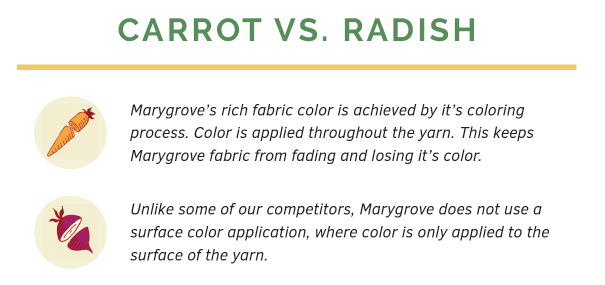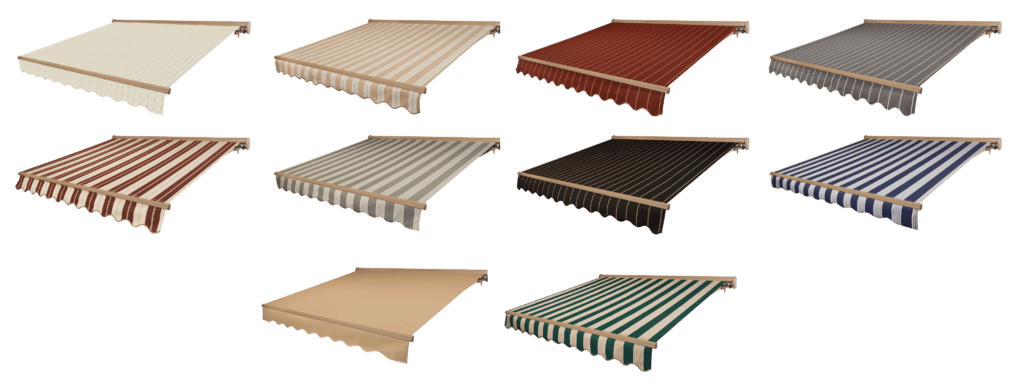Not only can a fabric awning add dimension and interest to the outside of the home, it can also offer durable protection against the elements. That protection only works if the awning is made of great fabric that will last for a long time. So, what is the best material for awnings? The answer is all in the woven lines.
Options in Awning Fabric
There are so many options for awning fabrics, both for residential projects and for commercial awnings. Even given the wide swath of different types of awning fabrics, there’s a definite delineation in how much they protect from rain, light, and wear.
Natural fabrics vs. synthetic fabrics are a major question for property owners.
Canvas, Polyester, and Acrylic Fabric Features
Though natural materials have their uses, they don’t always make the best awning fabric. There are two basic types of material used for awning fabrics:
- natural materials
- synthetic materials
Canvas, which is a natural material woven from threads of spun out cotton, is strong and can be coated with protective layers to make it last longer. The problem is that natural materials break down in the sun and heat of the summer, and then again in the cold and wind of the winter.
The coating that makes a canvas fabric waterproof and fade resistant is generally made of synthetic material, even though the canvas beneath is made of natural cotton material.
Polyester fabric starts in the lab, not in a field. Though polymers occur naturally in the environment in things like rubber and silk, polyester is made up of petroleum. That’s right – it comes from the same place as the gas in your car.
Starting off as a liquid, manufacturers then put polymer from petroleum into a machine that creates long strands of durable thread. This thread is then woven together to create a tough, longlasting fabric.
Acrylic fabrics are made in a similar process, though acrylic fabrics can be made from either coal or from petroleum. Plastic is melted down, then pushed through a machine that makes spindles of thin threads that are the woven together.
The synthetic nature of both acrylic and polyester fabric awnings makes these types of awning more durable and less susceptible to damage from the elements. Awnings made of canvas fabric won’t last as long as those made of acrylic or polyester types of material.
What is Solution Dyed Fabric?
If you’re not familiar with textile manufacturing processes, then you understandably wouldn’t know the difference between solution dyed material and stock dyed material.
Solution dyed material puts the color into the fabric before it’s finished, rather than after it’s complete. Fabrics that are solution dyed are resistant to fading from the sun and harsh outdoor elements because as the color is stripped from the top layers of thread, the layers beneath still contain the dye.
On the other hand, stock dyed fabric is only dyed on the surface of the fabric after it’s been woven. The dye penetrates into the woven thread, but it can only go so far into the fabric. Imagine a huge vat of dye that large pieces of fabric are dipped into, essentially creating a stain on the outer portions of the fabric.
Both acrylic fabrics and polyester fabrics can be solution-dyed, but obviously canvas material cannot be. Clearly, canvas material isn’t manufactured in a facility, and natural cotton is created white or off white by mother nature. That being said, cotton canvas can be dyed before its woven, which will make it more resistant to fading.
Why stock dye instead of solution dye? Expense. Because solution dyed fabric must be dyed at the beginning of the process, there’s less versatility in the fabric. The manufacturer has to choose the color choices from early on in the process, making it less adaptable to the needs of buyers. The bottom line here – the higher quality of solution dyed fabric also comes at a higher expense.

The Importance of UV Resistance
The biggest way that awning fabrics are damaged has to do with the brutality of UV radiation from the sun. These UV rays are the same thing that we are trying to protect ourselves from by using an awning.
Material can be certified as being resistant to UV rays through the International Association for Applied UV Protection. Called UV Standard 801, fabrics certified to this standard are able to protect from ultraviolet radiation in higher levels than is generally found in the United States.
In fact, the UV protection offered through UV Standard 801 is measured with the highest area of UV exposure in the world in mind, Australia. Where the UV index generally sits between 6 and 8 in North America during the warmest months, in Australia in the summer the UV index is 10 to 14. UV Standard 801 also rates for the most sensitive skin type.
Considering how much the exposure to UV rays wears down the awning material, it drives the point home of how much damage the sun can do to our bodies. Lack of UV protection can lead to skin damage ranging from a sunburn to aging and all the way to even skin cancer.
All the more reason to utilize an awning to protect us from the harsh summer rays. Outdoor fabric awnings that are rated for UV Standard 801, like those offered by O’Bravia, give an incredibly high amount of protection from the sun’s radiation. Sunbrella awning fabric is also highly rated for UV protection, keeping out up to 98% of the sun’s harmful rays
Caring for Awning Fabric
Though great awnings made from grade fabrics will last for years without fading, they are more durable when they’re well cared for.
A tried and true but simple way to keep outdoor material on an awning clean is to spray it off monthly with a simple garden hose. This keeps the fabric from collecting dirt that can get ground into the fibers.
A fabric awning can be cleaned without taking it off of its frame. Once rinsed, allowing it to air dry in the sun will help to prevent stains or mildew spots. It’s also possible to spot clean when there are specific, targeted areas that need to be cleaned.
Though awning fabrics made from acrylic and polyester material are durable, they can still sometimes get stained out in the elemets. Using a degreaser or some diluted bleach mixture on spots as soon as the are visible will help maintain the look of the awning without affecting durability.
Be sure to thoroughly rinse any cleaner that you use to clean your awning, and always use a soft bristled brush to clean it.
For further maintenance and to increase the lifespan of a fabric awning even further, you might consider a retreatment for improved long term performance. Treatments like Tex’Aktiv and 303 Fabric Guard can be applied after a thorough cleaning and will lengthen the lifespan of a fabric awning. You can do this yourself, or you can hire a professional to take care of it.
Regular cleaning of high quality awning fabrics is easy and straightforward.
Warrantied Awning Fabric
Most people are familiar with a warranty on a dishwasher or a car, but awning fabric can come with a warranty as well.
O’Bravia fabric awnings and Sunbrella fabric awnings both come with a five year limited warranty that covers fading and damage from mold, mildew, and sunlight. Though this warranty doesn’t replace awning fabric that is intentionally damaged by people, it does cover elemental damage from sun, rain, wind, and water.
Keep in mind that the fabric itself is the only thing that’s covered by a fabric warranty, not the fixtures or frame that are part of the awning.
The lifetime of outdoor fabric on an awning that’s well maintained can be up to 10 years with the right care and maintenance. Depending on the location of your home, including climate and weather realities, the fabric could last even longer.
Why the Fabric of an Awning Matters So Much
Protection is the watch word when choosing an awning material, while durability is close behind. Whether the look of your home is traditional or contemporary, the awning that you choose should match the style and functionality that you’re looking for.
In the search for the right outdoor shade covering, each manufacturer offers something a little different. What doesn’t change is the importance of thick, UV protective, fully dyed fabrics that continue to perform year after year.
An outdoor awning is an investment, no matter what kinds of textiles it’s made from. Finding the right material that will suit your needs and budget always starts with knowing your options. Understanding the science behind awning material for residential areas can help you to make a decision that’s right for your family.
The UV protection and hardy durability offered by high quality awning fabrics won’t ever let you down. There’s every reason to enjoy more time outside when you’ve got a beautiful, longlasting awning to shade your family.
